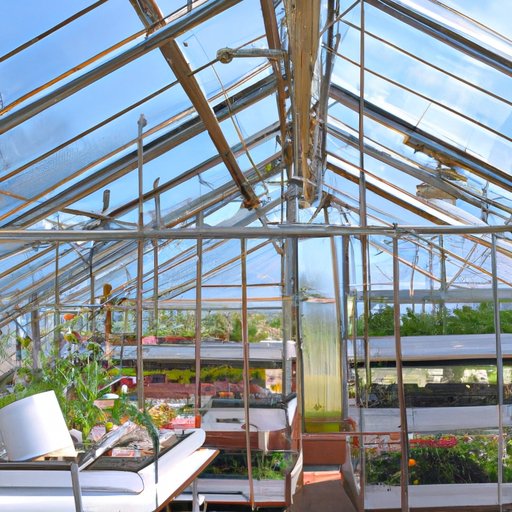Introduction
A greenhouse is a great addition to any backyard or garden. It allows you to grow plants and vegetables year-round, regardless of the climate. Not to mention, it’s a fun and rewarding project to build your own. This article provides a step-by-step guide to building a greenhouse and includes eco-friendly building practices and tips for growing plants. Whether you’re a seasoned gardener or a beginner, this guide will help you create your very own eco-friendly oasis.
Step-by-step guide on building your own greenhouse
Before you start building, it’s important to gather all of the necessary materials and tools. Some of the basic materials required include:
- Wooden planks
- Greenhouse plastic or glass panels
- Screws and nails
- Door hinges and handles
- Roofing materials
- Ventilation equipment
- Basic tools, such as a saw, hammer, screwdriver, and drill
Once you have all of the necessary materials, follow these steps to build your greenhouse:
- Choose a level site for your greenhouse. Clear any debris or vegetation and level the ground.
- Build a foundation using wooden planks or concrete blocks.
- Construct the frame using wooden planks. Attach the frame to the foundation using screws or nails.
- Install the door, including hinges and handles.
- Add roof panels and secure them in place.
- Install the greenhouse plastic or glass panels. Make sure to provide proper ventilation options and seal all edges for insulation.
- Add any necessary equipment and finishing touches, such as gutters and a watering system.
Remember, building a greenhouse is not an exact science, and you may need to make adjustments along the way. Here are a few extra tips to help you along with the process:
- Measure twice, cut once.
- Wear protective gear, such as safety glasses and gloves, when using power tools.
- Use treated or decay-resistant wood to protect against moisture damage.
Eco-friendly greenhouse building
Building an eco-friendly greenhouse not only benefits the environment, but it can also save you money in the long run. Greenhouses can be resource-intensive, using up energy for lighting, heating, and cooling. However, there are many sustainable materials and practices you can use to reduce your greenhouse’s carbon footprint. Here are a few eco-friendly building practices:
- Use reclaimed wood or recycled plastic for construction.
- Install energy-efficient windows and insulation.
- Implement passive solar heating and natural ventilation to regulate temperature and humidity levels.
- Use rainwater harvesting for your watering system.
- Compost your plant waste instead of throwing it away.
Tips for designing and planning your greenhouse
Designing your greenhouse to suit your specific needs is essential to its success. Proper orientation, size, ventilation and location are important factors to consider when planning your space. Here are some tips for designing and planning your greenhouse:
- Choose the right orientation for your greenhouse based on your latitude. Generally, you’ll want to face your greenhouse south in the Northern Hemisphere and north in the Southern Hemisphere.
- Consider the size of your greenhouse. You want to make sure that there is enough space for your plants and for you to move around comfortably. Additionally, consider the size of the plants and pots you’ll be using, and make sure to measure any pathways for accessibility.
- Determine the right type and amount of ventilation for your greenhouse to prevent condensation and regulate temperature.
- Choose a location that offers the most sunlight, has proper wind exposure and drainage, and is easily accessible from your home.
A beginner’s guide to growing plants in a greenhouse
Greenhouses are ideal for growing plants year-round, but you need to maintain the right temperature and humidity levels for optimal growth. Here are some tips for growing plants in your greenhouse:
- Prepare your soil by adding compost or other organic matter to improve drainage and nutrition.
- Choose plants that are adapted to the climate and environment in your greenhouse. Common plants to grow include tomatoes, cucumbers, peppers, and herbs.
- Maintain the right temperature and humidity levels for your plants, depending on their specific needs. Generally, aim for a temperature between 65°F to 75°F during the day and 55°F to 65°F at night.
- Avoid overcrowding your plants and keep a careful eye out for common greenhouse pests and diseases, such as whiteflies, mealybugs, spider mites, and powdery mildew.
Alternative greenhouse designs
If you’re looking for more unconventional greenhouse designs, there are many options available to you. Some popular alternative greenhouse designs include:
- Geodesic domes – Highly efficient and structurally sound, these domes offer a unique and innovative space for greenhouse use. Their aerodynamic structure means they can withstand strong winds and snow loads, making them ideal for colder climates.
- Earth shelters – Using the earth as an insulating material, these structures require less energy-intensive heating and cooling. They also offer a wider range of temperature stability.
- Converted shipping containers – This option repurposes old shipping containers into greenhouses, offering an eco-friendly solution for reusing materials. With the proper modifications, they can be transformed into an efficient and cost-effective greenhouse.
Conclusion
Building a greenhouse can be a fun and rewarding project that allows you to enjoy gardening and growing plants all year round. Using eco-friendly building practices and proper planning and design ensures that your greenhouse is not only good for the environment but efficient and successful. This comprehensive guide has provided you with everything you need to know to build your own greenhouse and grow your own plants.
Remember, building a greenhouse is a process that requires patience, attention to detail, and a bit of experimentation. By following these guidelines and tips, you can customize your greenhouse to fit your unique needs and preferences.
